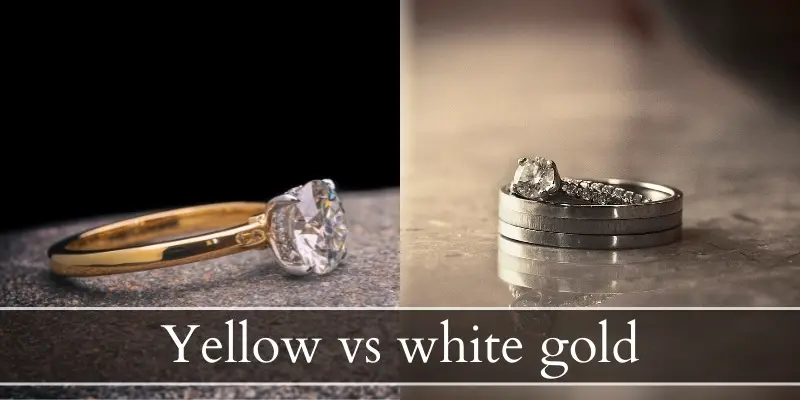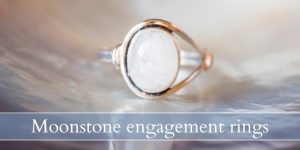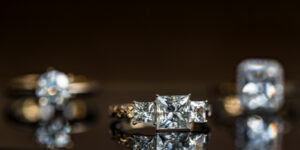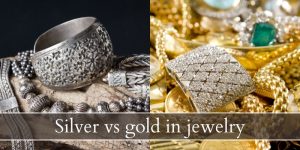White gold and yellow gold are two of the most common options you have when looking for gold jewelry. You can find them in watches, rings, earrings, bracelets, even simple things like dog tags.
There’s always a debate between which works better for jewelry, and the fact that white gold is often confused for silver isn’t helping its case. But the better informed you are, the better you can make a decision on a piece of jewelry you will pay a hefty sum for. So let’s take a look at the main differences between yellow and white gold, and we’ll touch on rose gold as well.

White gold vs yellow gold
The main difference between yellow gold and white gold is their final color. Both golds are alloys and they can be made to have either a yellow or a white appearance. White gold can further be coated with rhodium, to enhance the color.
Yellow gold tends to be softer than white gold, due to the other metals in the alloy. Yellow gold is also the traditional choice for engagement rings and wedding bands, though they are also easily available in white and rose gold as well.
What is white gold made of ?
White gold is made of an alloy of pure gold, and metals like palladium, nickel, zinc, sometimes silver. The higher the karat, the more pure gold is in the alloy, and the yellower the white gold. For example 18k white gold has a distinct yellow hue, while 14k white gold is almost completely white.
To combat this, white gold is often plated with rhodium, to get a perfectly white finish. This plating can and does wear off in time (years), so you may have to re-plate the jewelry every now and then.
Read also: Oval Diamond Guide
What is yellow gold made of ?
Yellow gold is almost always a gold alloy, with differing gold purity (check the karats). The final color of the yellow gold again depends on how much pure gold there is. The more gold, the yellower the final color.
For example 24k pure gold has a deep, almost incandescent warm yellow color. 18k yellow gold has a lighter yellow color with less warmth. And 14k yellow gold has even less gold, so an even colder yellow hue, and it may cross into rose gold if more copper is added.
Yellow gold is the traditional choice
If you’re looking for guidance for a piece of jewelry that has a lot of meaning and tradition behind it, go for yellow gold. This is the color usually associated with ‘good, expensive’ jewelry, engagement rings, wedding bands, and heartfelt yet expensive gifts.
White gold is not a modern color by any means, but the power of tradition cannot be denied. Since most people consider yellow gold to be the gold color, white gold often confuses people. If it’s an especially well plated (rhodium white) piece people will often assume it is silver. Very few will assume it is platinum.
Our own wedding bands are 14k white gold, because we don’t like the look of yellow on our skin, as we both have a cool undertone. Not everyone can wear gold jewelry and get away with it.
White gold offers a silvery-white color
If you only care about color for your jewelry, then the main difference is how both gold colors appear either white or yellow.
Yellow gold ranged from pure, deep warm yellow to a very pale yellow, depending on the karat. White gold ranges from a very warm silver to pure white, depending on the karat and whether it’s rhodium plated or not.
Yellow gold tends to be a bit softer than white gold
Because yellow gold does not have very strong, dense materials it may end up a bit softer than white gold. The higher the karat (18k and up), the more gold there is in the alloy, which makes for a soft piece of jewelry that is easy to bend and scratch.
The usual alloy materials for yellow gold are copper and zinc. Copper is even softer than pure gold, and only zinc offers a bit of structure and resistance.
By comparison white gold has more alloy materials, and they are a bit stronger. White gold cannot go further up than 18k, otherwise it would stop being white.
The usual version of white gold is 14k, with palladium and zinc thrown into the mix. Compared to the softer 18k and 22k yellow gold, white is harder to bend and scratch.
Is white gold really gold ?
Yes, white gold is really gold in that is has pure gold in about half of its composition (14k) or 3/4 of its composition (18k).
Even yellow gold has some alloy metals, otherwise it would be too soft. Any stones set in 22k and 24k gold are at risk of falling out much easier than in 18k yellow gold. Again, the higher the karat the softer the jewelry, and white gold is one of the most common setting golds. Meaning the material that holds the stones on jewelry.
Rhodium plating on white gold
White gold is often plated with rhodium, to achieve a perfectly white, bright sheen. This makes people doubt that it is actual gold. But it is, and the plating is there only to provide the final color.
If you’d like your white gold to retain a slight yellow sheen, simply ask the jeweler not to plate it with rhodium. And if you ever have a change of heart and want your white gold piece to be yellow, you can always have it gold plated or have the rhodium stripped.
Where does rose gold fit into all of this ?
Rose gold is very similar to white gold, in that it is usually a 14k gold but the alloy metals are different. There is a lot more copper added to the mix, leading to a very rosy-pink hue.
For comparison 18k rose gold has a noticeable yellow-pink color, while 14k is almost completely pink, with a silver-grey undertone.
Rose gold is actually as popular as white gold, and they both compete for second place for wedding rings and engagement rings. This type of gold is not new either, but it has become fashionable only in the past century.
It was originally called ‘Russian gold’, after the Russian jeweler Carl Faberge – yes, that Faberge – and it’s been a very popular metal in Europe ever since.
Is platinum better than white gold ?
Platinum is indeed better than white gold, because it is much more scratch resistant, is very difficult to bend – and thus work with – and has a pure white color and sheen. White gold is composed of several metals, including gold, while platinum is a standalone metal.
That being said, platinum is usually more expensive than gold. Not by gram, but by how much platinum goes into making a piece of jewelry. Platinum is a very dense metal, denser than any form of gold.
So the same wedding band, one made of platinum and one made of white gold, will have significantly different prices simply because the platinum one is about twice as heavy as the gold one.
The good news is that when you put rhodium-plated white gold and platinum next to each other, they are almost indistinguishable. So it’s much easier on your pocket to get a white gold piece of jewelry than platinum.
Which gold for an engagement ring ?
18k yellow gold is traditional for engagement rings and wedding bands, though each person is completely free to choose the metal they like the most.
If you’re going to a very classic, traditional style, you’re likely getting a diamond engagement ring. This will also raise the cost, and there are ways to work around that if you still want to get the usual 18k yellow gold.
A nice feature of yellow gold and white diamonds is how the diamond pops, as the two colors don’t fade into each other. However you can get a similar effect with rose gold, since it will get you a nice contrasting color.
If you go for white gold, like we did, the entire ring will appear white. If that’s what you’re aiming for then go right ahead, the combination is simple yet elegant.
Always look at the karats when buying gold
Whatever gold color you end up buying, the karats are actually a bit more important. The karats on your gold jewelry will dictate several things, including:
- how much the piece costs, higher karat pieces are worth more
- how scratch-resistant the pieces are, higher karat pieces need regular polishing
- how easily they will tarnish, lower karat (like 10k and 8k) pieces will tarnish as they have very little gold left in them
Try and find a happy medium. You need to take into account your tastes, your budget, and what is available or what the jeweler can do for you. In the end jewelry should bring happiness, not stress and worry.

I’m the main author for jewelrymaterialguide.com. I started this site after we did tons of research before our wedding and noticed that there is information about rings, jewelry, and so on that is really hard to find on the internet.






